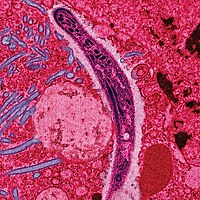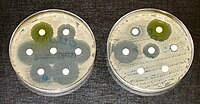
Black spot infection in juvenile steelhead trout increases with stream temperature in northern California
Sign Up to like & getrecommendations! Published in 2017 at "Environmental Biology of Fishes"
DOI: 10.1007/s10641-017-0599-9
Abstract: Climate change will increase water temperature in rivers and streams that provide critical habitat for imperiled species. Warmer water temperatures will influence the intensity and nature of biotic interactions, including parasitism. To better understand the… read more here.
Keywords: temperature; water; infection; black spot ... See more keywords

Spatial and climatic factors associated with the geographical distribution of citrus black spot disease in South Africa. A Bayesian latent Gaussian model approach
Sign Up to like & getrecommendations! Published in 2018 at "European Journal of Plant Pathology"
DOI: 10.1007/s10658-018-1435-6
Abstract: Citrus black spot (CBS), caused by Phyllosticta citricarpa, is the main fungal disease affecting this crop and quarantine measures have been implemented. The role of climate as a limiting factor for the establishment and spread… read more here.
Keywords: climatic variables; citrus black; black spot; disease ... See more keywords

Newly isolated bacterium Tenacibaculum sp. strain Pbs-1 from diseased pearl oysters is associated with black-spot shell disease
Sign Up to like & getrecommendations! Published in 2018 at "Aquaculture"
DOI: 10.1016/j.aquaculture.2018.04.049
Abstract: Abstract In recent years, black-spot shell disease has appeared on the shells of Akoya pearl oysters, Pinctada fucata, causing serious problems in cultured pearl production. This disease was believed to be caused by boring of… read more here.
Keywords: strain pbs; black spot; disease; shell ... See more keywords

Antifungal efficacy of ursolic acid in control of Alternaria alternata causing black spot rot on apple fruit and possible mechanisms involved
Sign Up to like & getrecommendations! Published in 2019 at "Scientia Horticulturae"
DOI: 10.1016/j.scienta.2019.108636
Abstract: Abstract Black spot rot caused by Alternaria alternata is becoming a main postharvest disease on apple fruit. The objective of this study was to elucidate the antifungal efficiency of ursolic acid (UA) against A. alternata… read more here.
Keywords: spot rot; apple fruit; black spot; apple ... See more keywords

Transcriptome Analysis of Resistant and Susceptible Pecan (Carya illinoinensis) Reveals the Mechanism of Resistance to Black Spot Disease (Colletotrichum fioriniae).
Sign Up to like & getrecommendations! Published in 2023 at "Journal of agricultural and food chemistry"
DOI: 10.1021/acs.jafc.2c08434
Abstract: Pecan, Carya illinoinensis (Wangenh.) K. Koch, is an important dried fruit and woody oil tree species grown worldwide. With continuous expansion of pecan cultivation, the frequency and scope of diseases, especially black spot disease, are… read more here.
Keywords: disease; resistance black; resistance; spot disease ... See more keywords

First Report of Black Spot Disease Caused by Alternaria alternata on Persimmon Fruit in China.
Sign Up to like & getrecommendations! Published in 2023 at "Plant disease"
DOI: 10.1094/pdis-02-23-0234-pdn
Abstract: Sweet persimmon is native to Japan and valued for its fruit, which are high in sugar and vitamins. In October 2021, symptoms were observed on persimmon (Diospyros kaki L. cv. Yangfeng) fruits in cold storage… read more here.
Keywords: disease; fruit; rpb2; alternaria alternata ... See more keywords

First report of Alternaria tenuissima causing leaf black spot on pecan in China.
Sign Up to like & getrecommendations! Published in 2021 at "Plant disease"
DOI: 10.1094/pdis-04-21-0757-pdn
Abstract: China is one of the largest markets for pecan (Carya illinoinensis) consumption in the world, and also, pecan production in China has been increased by years since 2008 (Zhang et al. 2015). From July to… read more here.
Keywords: alternaria tenuissima; spot; black spot; leaf black ... See more keywords

First Report of Black Spot Caused by Penicillium citreosulfuratum on Saffron in Chongming Island, China.
Sign Up to like & getrecommendations! Published in 2021 at "Plant disease"
DOI: 10.1094/pdis-05-21-1038-pdn
Abstract: Saffron (Crocus sativus L.) is a world-famous source of dye and spices and an important medicinal plant, which is cultivated on a large scale on Chongming Island (31.62° N, 121.39° E) in Shanghai, China. In… read more here.
Keywords: saffron; citreosulfuratum; black spot; chongming island ... See more keywords

Identification of Two Fungal Pathogens Responsible for Liriodendron chinense × tulipifera Black Spot and Screening of Trichoderma sp. for the Disease Control.
Sign Up to like & getrecommendations! Published in 2022 at "Plant disease"
DOI: 10.1094/pdis-06-21-1266-re
Abstract: Liriodendron chinense × tulipifera black spot is a newly discovered disease that causes yellowing and early shedding of leaves, affecting the growth of Liriodendron trees and significantly reducing their ornamental value as a garden species.… read more here.
Keywords: disease; chinense tulipifera; black spot; liriodendron ... See more keywords

First Report of Black Spot Caused by Neoscytalidium dimidiatum on Sisal in Guangxi, China.
Sign Up to like & getrecommendations! Published in 2020 at "Plant disease"
DOI: 10.1094/pdis-08-20-1669-pdn
Abstract: Sisal (Agave sisalana Perrine) is an important hard fiber crop that is widely planted in Guangxi, Guangdong, Hainan, Yunnan, and Fujian provinces, China. In July 2019, a new leaf disease of sisal with a disease… read more here.
Keywords: neoscytalidium dimidiatum; sisal; black spot; dimidiatum ... See more keywords

The TNL gene Rdr1 confers broad-spectrum resistance to Diplocarpon rosae.
Sign Up to like & getrecommendations! Published in 2018 at "Molecular plant pathology"
DOI: 10.1111/mpp.12589
Abstract: Black spot disease, which is caused by the ascomycete Diplocarpon rosae, is the most severe disease in field-grown roses in temperate regions and has been distributed worldwide, probably together with commercial cultivars. Here, we present… read more here.
Keywords: black spot; rdr1; resistance; gene ... See more keywords